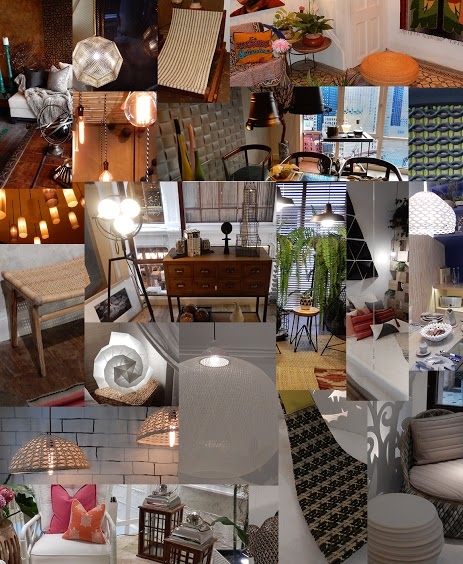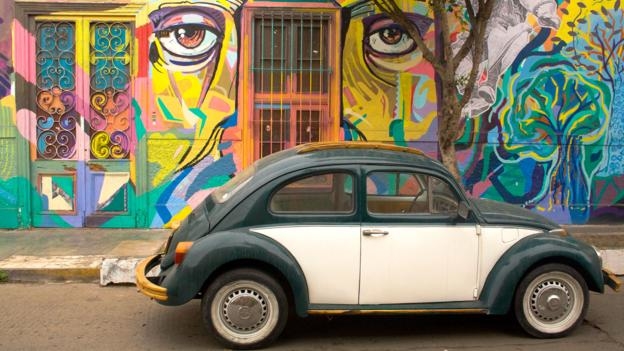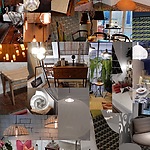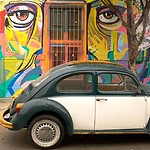Observational research
Starting with the first phase of the market research, an observational research has been done in order to have a better understanding of the Peruvian society and the world they are living in. We have chosen the upper middle class of the Peruvian society as our target group. On the internet a lot of facts and numbers can be found about the Peruvian society, but the observational research was being held in order to find out how these people live and act in daily life; what do they do on a day, what do they find important? Furthermore through the observational research we wanted to find out what people consider as beautiful and if they are aware of the plastic pollution problem in Peru.
For our observational research we went to several public locations and events where the upper-middle class of the Peruvian society can be found. These places include restaurants, bars and stores in Barranco, the area where L.O.O.P. sells their products, and also an interior exhibition called Casacor in Callao.
We observed the exterior of the shops, restaurants and also the people who visit these places. We made up a set of questions which we kept in mind during conversations with people. These questions were divided in two parts: personal information about the person/store and awareness about the plastic pollution problem in Peru. We spoke to different people; since their identity is kept anonymous these people’s real names are not mentioned.
Casacor
Casacor is an interior exhibition held every year in a particular district in Lima. An old, abandoned building is being reconstructed into a beautiful house in which the most extravagant interior design is implemented. The building consists of several chambers with all different interior-styles from various designer- and interior shops. Various selected interior shops from Lima have the opportunity to show their collection and the building contains small restaurants and coffeebars where visitors can eat or drink something. Casacor is every year a popular event; people come there to gain inspiration for their own houses but the event attracts also a lot of designers, architects and furnish makers.
Every room in the Casacor had a different style. We’ve seen retro, modern, vintage, fancy and very clean designs. All of the rooms had a theme, following with the right interior, colors and ambiance. Interesting was to see that the interior of the future in the casacor in the Netherlands already sold in way more cheaper shops. To create a certain ambience we found the light was very important. It is hard to define “Thestyle” of the Casacor.
The public that is being attracted by the event can be mainly described as the ‘fortunate layer’ of the Peruvian society. A lot of couples and families were seen and as you could tell from their appearances they all looked well-groomed.

The architect
Being a 40-year old father of one child, Carlos Vasquez came with his wife, son and mother in law to Casacor. Carlos works as an architect for the design studio in San Isidro, Lima. He and his family also live in San Isidro, one of the upscale districts of the capital city and known for Peruvian artist living in this area. The purpose of his visit was to gain inspiration for his work as an architect. Furthermore he mentioned he likes the ambiance of the event and liked to take his family on a nice trip.
Carlos tells that he is aware of the severe plastic pollution problem in Peru and that he cares for the environment. He separates waste and recycles plastic at his home. According to him most Peruvians know about the plastic pollution problem, but they don’t realize that it actually affects their own environment and don’t feel the urge to do something about the pollution problem. “Peru is a developing country; most people care mostly about their primary needs; they don’t have the luxury to buy a more costly product that would be environmental healthier.”
The favourite interior piece from Carlos is a lamp, because it can create a nice ambience which he finds very important to have in his house.
Father and daughter Sara & Renan
Sara, an 18-year old art-student, and her father Renan (53 year) came to visit Casacor because Sara found this event really interesting since she is studying art and loves interior design. Sara and Renan seemed to know nothing really about the plastic pollution problem at first; they didn’t seem to care about the questions concerning the environment. When the subject recycling came up Sara told us that there is being recycled at her university, but that she doesn’t recycle at home. Sara and Renan live in the district Jesus Maria, a lower- to middleclass area. We concluded these people don’t belong to our target group, but it was interesting speaking with them.
Family from San Borja
Living in San Borja, this family seems to care and be aware of the plastic pollution problem. The company where the 46 year-old Victor works as the co-director does a lot of things in order to stimulate a healthy environment; they recycle waste and do beach-clean ups with the employees of the company. The 45 year old woman Cristina told us that they don’t recycle at home, since there is no such recycling habit in Peru as there is in Europe for example. “We could seperate waste at home, but then it will all end up at one huge waste belt.” says Cristina.
Their 10-year old son Leonardo interrupted his mother by saying that at his school a lot of recycling is being done. They always seperate their waste and every once in awhile they have to take plastic bottles from home with them in order to collect a great amount of bottles which they give to ‘poor children’ who could sell the bottles. The school where Leonardo goes to is an international primary and high-school institute located in Santiago de Surco, a district known for it’s exclusive universities.
The family visited the Casacor because Cristina loves interior design and thereby came the advantage that Victor received free tickets from his company. Cristina said that she really loves antique and styles with a lot of wood; her favourite interior design object is a dinner table.
Kerima
The first thing we asked Kerima was if she knew L.O.O.P., and surprisingly she did! Most people didn’t knew L.O.O.P, but it turned out that Kerima was an old roommate from Nadia (one of the directors of L.O.O.P.) Nowadays, Kerima lives in Miraflores and she is an interior designer for KGB arquitectura who participated in the building of Casacor 2014. Kerima’s favourite interior style is Swedish and minimalistic: “I actually love the Dutch design which has those beautiful minimalistic and Swedish influences, i really love it!” she said. Kerima is active when it comes to participate in activities concerning the environment. She recycles at home and explicitly mentions that she doesn’t use straws and other additional plastic. Kerima’s favourite interior piece is a rug; that would really makes her house cosy.
Gabriela
Gabriela is a 43-year old woman who came to visit Casacor together with her mother. Gabriela doesn’t work; she is a housewife living together with her husband in Miraflores. One of Gabriela’s hobbies is to design her house and that is why she visited Casacor. She is aware of the pollution problem in Peru, but doesn’t recycle herself at home or does other activities concerning the environment. When we showed her our L.O.O.P. bag and asked her if she would use this type of bag instead of the plastic bags they use in the supermarket, she answered that she would definitely use it. Her favourite interior piece is a dinner table. Gabriela shops in a lot of different shops in order to design her house.
From the casacor experience we concluded that the public visiting this events are fortunate Peruvians of which the majority belongs to the upper-middle class from Peru. They live in the wealthier areas of Lima such as: Miraflores, San Isidro, San Borja and Barranco. They have proper jobs and seem to care about the environment. Most of the people are willing to do something about the plastic pollution problem, but mentioned that it is difficult in Peru to recycle, because they find it difficult how to recycle since there are not so much opportunities to for example separate waste or recycle. There are few central recycle points and there is no such ‘caring for the environment’ ambiance in general in Peru.
Barranco
The district where we did the observational research and where L.O.O.P. mainly operates and is located is called Barranco, and can be described as the bohemian, arty district of Lima with a lot of bars, restaurants and independent designer shops. L.O.O.P. sells their products mostly in stores situated in Barranco so that is the main reason why we decided to hold the observational research in this district. In order to have a better understanding of the shops and their consumers, the observational research was also held in a few shops in Barranco. The most important questions we asked to the merchants were: “What is the strength of this store?” and “What is the message of the store, why do people buy here?”. Furthermore we wanted to know if people find it important if a designer is coupled to a product.
Tienda del Mac giftshop
Av. Grau 1511
Located in Barranco in the hall of the museum of contemporary art, the ‘Tienda del Mac’ gift shop sells products related to exhibitions held in the museum. It is a very small shop were designer product mostly modern art has been sold. The strength of the store is that they offer products such as bags, posters, books which are connected to the contemporary art of the museum since they are created by designers. The products Tienda del Mac sells are very interesting and most of the products are real designer products. One of the products that characterized the store where the bags, wallets and key hangers made out of recycled car tires from the slums. The saleswoman explained that these are the most-sold products of the shop. 'People are interested in these kind of products because it is made of sustainable and strong material and is easy to maintain' according to the saleswoman. She also mentioned that the story and appearance in combination with the quality of these products attracts people. A designer is not necessarily required in order to create successful selling products according to the saleswoman; she mentioned that if the story, appearance and quality of the product are well-mixed it should be enough. Furthermore the woman explained that coupling an independent designer to a product is an up-coming trend since approximately 5 years. Coupling a designer to a product becomes more important than before, but still quality and appearance comes first.
The majority of the public that visits the Tienda del Mac are fortunate Peruvian and tourists. These tourist are mainly coming from Chile, Mexico and the United States.
Cuatro en un Baúl
This store has a cosy and traditional look with a hint of modern design. Cuatro en un Baúl sells mainly furnishment and other decoration pieces for in your house. The store is mainly characterized by the combination and fusion of recycled and new products. The message of the store is: “Giving not used products a second life”. One of their most sold products is a round table designed with from pully blocks. Next to this product, Peruvian art toy from the designer Rafael Lanfranco is also sold in good amounts. (FOTO!). People come to this store because they are looking for specific, special things for in their house. The shop has a lot of wooden furniture so people visiting Cuatro en Baúlare probably attracted to wooden furnishment. The type of people who buy at Cuatro en un Baúlare described by the store owner as fortunate Peruvians mainly living in Barranco, Miraflores, San Borja and San Isidro.
Connecting a designer to an object is not necessary according to the owner of the store. “Most of the objects in this store are not made by a designer; people search for special things and don’t really care about whether it is created by a designer or not. As long as they find what they are looking for, they will buy.”
Plantique
Plantique, as the name says, is a store known for the plants they sell. These plants are mostly small succulent plants or cactuses in an extraordinary vessel which is for example made out of glass and is hanging on the ceiling. (FOTO) These lamps are also known as ‘ecosystem lamps’. Next to these typical products, Plantique sells a lot more products related to interior design. The store is very hip and retro and fits in perfectly within the arty district Barranco. They already sell L.O.O.P. bags and find their green image very important.
People who buy at Plantique are people who like design and extraordinary products. These people are mainly young Peruvians and tourists. The most sold product of the store are the ecosystem lamps and vessels. Plantique finds the quality of the product the most important, but they also see the importance of coupling a designer to a certain product although they value quality higher. The products sold at Plantique mostly have a minimalistic, scandinavian, modern design. Geometric shapes, pastel colors, a lot of wood and aztec prints are included in a lot of the hip products.
Vernacula
Vernacula is a store located in a big building including a small restaurant-bar and clothing shop. The building is very interesting since it looks like a normal house with different chambers full of various small stores. What stands out is that this store sells a lot of original Peruvian products: the typical patterns and colours from the highlands. This is one of the forces from the store; they want to sell high-quality authentic Peruvian products such as wallets, bags, agenda’s etc. Comparing to small stores on the street we have seen personally, the prizes in Vernacula are at least twice as high, but it is obvious that the quality of the products and the finishing of the products looks better at Vernacula. Vernacula does not only sell products from Peru but also from other countries from all over the world (Indonesia, Africa), but their specialty is Peruvian products. The most sold products are the ones from the brand ‘Siblings Army’, especially the wallets. We assumed that more tourists would buy at Vernacula, since we would expect tourists are more attracted to the typical Peruvian patterns and colors, but it turned out that just as much Peruvians buy products from Vernacula.
Vernacula is a store containing more products that are from a brand. The saleswoman told us that they sell products from good quality and that these products don’t necessarily have to contain a brand as long as the quality stands out.
After visiting the different stores we concluded that Barranco is really a bohemian, arty district from Lima with, compared to the rest of the city, a lot of trendy stores and restaurants. The people attracted by these hip places are mostly young-adolescent fortunate Peruvians and tourists. The different stores in Barranco all have a different message, but they all sell in the same product categories: interior design products and second-hand products. Most of the stores sell products made of recycled material as well or are willing to sell recycled products in their store. They would all sell the L.O.O.P. bags in their store when we asked them for example. Another interesting result is that most people don’t find it important whether a products is from a designer or not. The quality of a product is seen as more important than the coupling to a designer.


